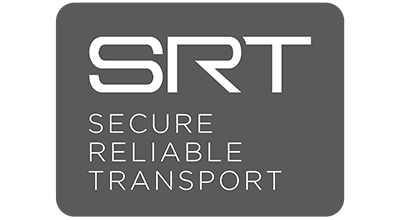Info Srt- a new transport protocol

What is Secure Reliable Transport (SRT)?
SRT is a new transport protocol that delivers high-quality video at low latency over noisy, public networks like the Internet. To give you a bit of background, video/audio packets sent between two points encounter a slew of transport obstacles like bandwidth fluctuations and packet loss. As a result, video quality at the endpoint comes out at lower quality, which is can hamper the product for all forms of IP video deployments.
The goal of SRT implementation is to solve that issue. The protocol optimizes video transport over unpredictable networks by adapting to real-time network conditions, minimizing packet loss and creating a better finished product. It also supports end-to-end AES encryption so streams are better protected at all points. Basically, SRT offers higher quality video streaming and greater security for all point-to-point workflows.
What Does This Mean For Me?
The new protocol is very practical for all sorts of video transport applications. In the realm of streaming, SRT helps content creators deploy pristine video from the source and maintain its integrity throughout distribution, improving QoS and overall viewing experience. This means getting your video all the way to viewers in exceptional quality.
This is especially useful for organizations where the LAN is congested and packet loss is common. For example, streaming from a crowded convention (everyone is fighting over the same LAN) to a production studio is bound to decrease the quality of the video transmission. Utilizing SRT as the transport protocol (as opposed to MPEG-TS, RTP or RTSP) helps to minimize these issues and delivers the video feed to the decoder destination optimally.
But this isn’t limited to congested LANs. For organizations like churches that stream between campuses, any delays in the interaction between two campuses can cause the experience to be poor for parishioners and time consuming for the service. But, by using SRT, video is transported from satellite campuses to the main campus (and vice versa) with minimal packet loss compared to RTSP or MPEG-TS, giving them a robust, reliable transport and maintaining optimal quality.
How Does Teradek Play a Role, and How Can I Start Using SRT?
Teradek is happy to be joining the SRT Alliance in implementing the protocol as an option in our professional Cube and Slice encoders (600/700 series). With the latest update to the firmware, SRT is now available and ready to go. As long as both endpoints support SRT, users can utilize the protocol for high-performance video transport.
We’ve made enabling SRT in Cube and Slice very simple. First, find and update your device’s firmware . After updating, log into your encoder’s web interface and navigate to Video Stream Output on the left-side panel. Go to the drop-down menu of supported transport protocols. SRT will appear as an option on the list.
After selecting SRT, you get 2 options for Server Mode: Enabled or Disabled. Enabled creates a public server while disabled creates a direct connection between two points. For either, a port number will be needed to connect, with a passphrase if one is set at the destination. For a direct connection, the destination IP will be needed.
Where is SRT Supported?
SRT can already be utilized for point-to-point transport between Teradek encoders and decoders, making it especially pertinent for video broadcasters to deliver pristine, optimized video from point to point.
But since SRT is still in the early stages of development, widespread implementation is still a work in progress. Aside from Wowza’s own Streaming Engine, other major live streaming platforms haven’t adopted SRT into their systems yet, meaning they can’t be used as endpoints. However, as more and more industry developers integrate the open source protocol into their systems, you can expect more across-the-board integration in the coming months. Live streaming won’t be far behind.
Relate Threads




